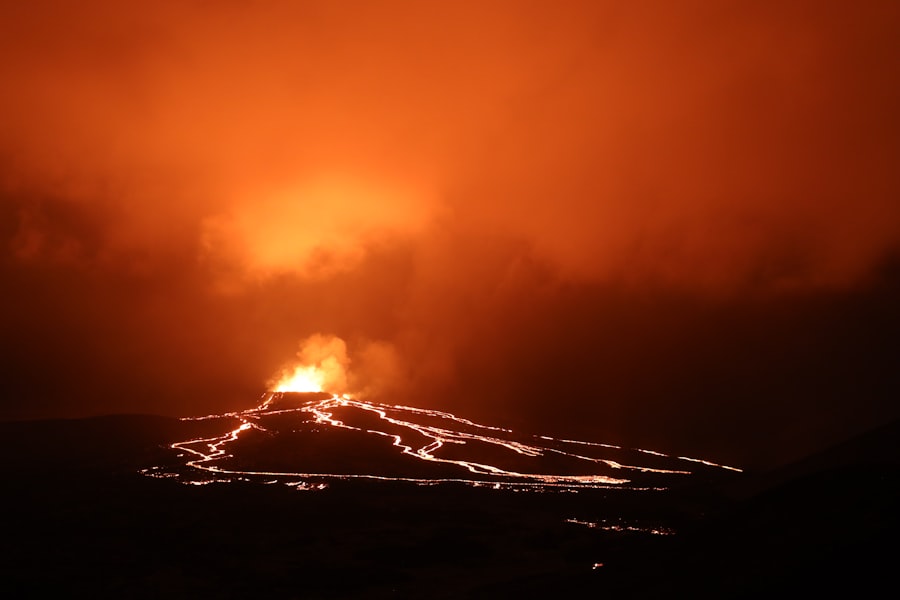Shield volcanoes are a fascinating geological phenomenon that captures the interest of scientists and nature enthusiasts alike. These majestic formations, characterized by their broad, gently sloping sides, resemble a warrior’s shield lying flat on the ground. Unlike their more explosive counterparts, stratovolcanoes, shield volcanoes are primarily built up by the flow of low-viscosity basaltic lava, which allows for the creation of extensive lava fields.
This unique structure not only defines their appearance but also influences their eruptive behavior and the surrounding ecosystems. The study of shield volcanoes provides valuable insights into volcanic activity and the processes that shape the Earth’s surface. They are predominantly found in hotspot regions, where magma from deep within the Earth rises to the surface.
The Hawaiian Islands serve as a prime example of shield volcanoes, showcasing the beauty and power of these geological giants. Understanding shield volcanoes is crucial for comprehending the dynamics of our planet and the potential hazards they pose to nearby communities.
Formation and Characteristics of Shield Volcanoes
The formation of shield volcanoes is a complex process that begins with the accumulation of lava flows over time. As magma rises from the mantle, it erupts onto the surface, where it spreads out in thin layers due to its low viscosity. This results in a broad, shield-like shape that can cover vast areas.
Over thousands of years, repeated eruptions contribute to the growth of these volcanoes, creating a gentle slope that can extend for miles. The gradual build-up of lava flows is what distinguishes shield volcanoes from other types, such as stratovolcanoes, which are characterized by steeper profiles and more explosive eruptions. In terms of characteristics, shield volcanoes typically exhibit a variety of features that reflect their eruptive history.
The surface is often marked by extensive lava tubes, fissures, and pahoehoe or aa lava flows, each providing clues about past volcanic activity. Additionally, shield volcanoes may have calderas—large depressions formed when a volcano collapses after an eruption—at their summits. These calderas can be quite expansive and may host lakes or other geological formations.
The combination of these features contributes to the unique landscape associated with shield volcanoes, making them a subject of interest for geologists and ecologists alike.
Notable Examples of Shield Volcanoes

Among the most notable examples of shield volcanoes are those found in Hawaii, particularly Mauna Loa and Kilauea. Mauna Loa is one of the largest volcanoes on Earth, rising over 13,000 feet above sea level and covering an area of approximately 2,035 square miles. Its sheer size and frequent eruptions make it a significant feature in the study of volcanology.
Kilauea, on the other hand, is one of the most active volcanoes in the world, with continuous eruptions recorded since 1983. The lava flows from Kilauea have created new land and reshaped the island’s coastline, demonstrating the dynamic nature of shield volcanoes. Another prominent example is Iceland’s Skjaldbreiður, which translates to “broad shield.” This massive shield volcano is known for its symmetrical shape and extensive lava fields that cover much of the surrounding landscape.
The unique geological setting of Iceland, situated on the Mid-Atlantic Ridge, contributes to its numerous shield volcanoes and geothermal activity. These examples highlight not only the diversity of shield volcanoes around the world but also their significance in understanding volcanic processes and their impact on local environments.
Eruptions and Lava Flows of Shield Volcanoes
| Volcano Name | Location | Frequency of Eruptions | Volume of Lava Flows |
|---|---|---|---|
| Kilauea | Hawaii, USA | Almost continuous | Over 3 billion cubic meters |
| Mauna Loa | Hawaii, USA | Once every few years | Over 5 billion cubic meters |
| Piton de la Fournaise | Reunion Island, Indian Ocean | Frequent, every few years | Varies, up to 100 million cubic meters |
Eruptions from shield volcanoes are typically characterized by their effusive nature rather than explosive outbursts. The low viscosity of basaltic lava allows it to flow easily across the landscape, creating extensive lava fields that can travel great distances from the eruption site. This type of eruption can result in spectacular lava fountains and rivers of molten rock that reshape the terrain over time.
The relatively gentle eruptions are often accompanied by lava lakes and fissure eruptions, which can create new landforms and alter existing ecosystems. The lava flows produced by shield volcanoes can vary significantly in their characteristics. Pahoehoe lava flows are smooth and ropy, while aa lava flows are rough and jagged.
These differences arise from variations in temperature and gas content during eruptions.
The potential for lava flows to encroach upon populated areas poses risks to human settlements, making monitoring and understanding these eruptions essential for safety and preparedness.
Impact of Shield Volcanoes on the Environment
The environmental impact of shield volcanoes is profound and multifaceted. On one hand, their eruptions contribute to the creation of new landforms and habitats, fostering biodiversity in areas that may have been previously barren. The nutrient-rich volcanic soil resulting from weathered lava can support lush vegetation and diverse ecosystems.
This transformation can lead to increased wildlife populations and new opportunities for ecological research. Conversely, shield volcano eruptions can also pose significant threats to local environments. Lava flows can destroy existing habitats, displacing flora and fauna while altering watercourses and soil composition.
The release of volcanic gases during eruptions can impact air quality and contribute to climate change over time. Understanding these impacts is crucial for developing strategies to mitigate risks associated with volcanic activity while preserving the ecological benefits that shield volcanoes can provide.
Shield Volcanoes and Human Activity

Human activity has long been intertwined with shield volcanoes, particularly in regions where these geological formations are prevalent. In Hawaii, for instance, communities have adapted to living in close proximity to active volcanoes like Kilauea. The cultural significance of these volcanoes is deeply rooted in Hawaiian mythology and traditions, with many residents viewing them as sacred sites.
However, this close relationship also presents challenges, as eruptions can threaten homes, infrastructure, and livelihoods. In addition to cultural impacts, shield volcanoes also play a role in tourism and economic development. Many visitors are drawn to Hawaii’s stunning landscapes shaped by volcanic activity, contributing to a thriving tourism industry.
However, this influx of tourists can strain local resources and create conflicts between conservation efforts and economic interests. Balancing human activity with environmental preservation remains a critical challenge for communities living near shield volcanoes.
Study and Research of Shield Volcanoes
The study of shield volcanoes is an essential aspect of volcanology that provides insights into volcanic processes and hazards. Researchers employ various methods to monitor volcanic activity, including remote sensing technologies, seismic monitoring, and geological mapping. These tools allow scientists to track changes in volcanic behavior and assess potential risks associated with eruptions.
Field studies play a crucial role in understanding the formation and evolution of shield volcanoes.
This knowledge not only enhances scientific understanding but also informs hazard assessments that are vital for public safety in areas prone to volcanic eruptions.
Conservation and Preservation of Shield Volcanoes
Conservation efforts surrounding shield volcanoes are essential for protecting both natural ecosystems and cultural heritage sites. Many regions with active or dormant shield volcanoes have established national parks or protected areas to preserve their unique landscapes and biodiversity. These initiatives aim to balance ecological preservation with public access for education and recreation.
Moreover, ongoing research into the impacts of climate change on volcanic regions underscores the importance of conservation efforts. As global temperatures rise and weather patterns shift, understanding how these changes may affect volcanic activity becomes increasingly critical. By prioritizing conservation initiatives, communities can safeguard their natural resources while fostering a deeper appreciation for the geological wonders that shield volcanoes represent.
In conclusion, shield volcanoes are remarkable geological formations that offer valuable insights into Earth’s processes while posing unique challenges for human communities. Their formation, characteristics, eruptions, environmental impacts, and interactions with human activity highlight the complexity of these natural wonders. As research continues to evolve, so too does the understanding of how best to study, conserve, and coexist with these magnificent structures that shape our planet’s landscape.
If you’re interested in learning more about natural phenomena like shield volcanoes, you may want to check out this article on storm chasing equipment and safety tips on Tornado Extreme. Understanding the equipment and safety measures involved in storm chasing can provide valuable insights into the science behind extreme weather events, including volcanic eruptions.

